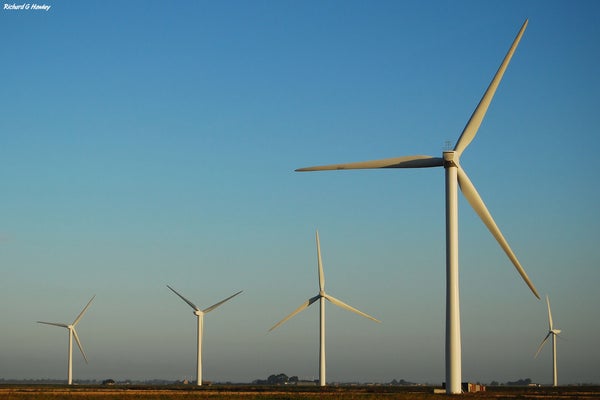This article was published in Scientific American’s former blog network and reflects the views of the author, not necessarily those of Scientific American
Earlier this month, the U.S. Department of Energy (DOE) released the latest iteration of its annual Wind Technologies Market Report, which pulls together a wealth of data to track trends in the cost, performance, and growth of wind energy.
The report found that U.S. wind energy will continue to be one of the lowest cost electricity generation technologies available, with the long-term wind electricity price available through a power purchase agreement coming in at about half the expected cost of just running a natural gas power plant.
Furthermore, stiff competition from both natural gas and solar energy are poised to push the wind industry to achieve even lower prices and higher performance through the development of bigger turbines tailored to maximize their output even in regions with less than optimal wind speeds.
On supporting science journalism
If you're enjoying this article, consider supporting our award-winning journalism by subscribing. By purchasing a subscription you are helping to ensure the future of impactful stories about the discoveries and ideas shaping our world today.
This post will review a few of the major U.S. wind energy trends tracked in the DOE report. For a full rundown, I suggest you check out the full report and associated slide deck.
Wind Energy Is One of the Cheapest Sources of Electricity in the United States
While the all-in price of wind energy directly depends on the wind speeds at a particular site, examining national trends in the installed cost of wind energy definitively shows that wind energy has become an extremely inexpensive source of electricity.
The average U.S. consumer pays about 12 cents per kilowatt-hour for electricity. That price includes the cost of generating power, the wires that deliver it from generators to our homes, and the cost of running the utility business. The actual cost of electricity generation alone is something like 2 to 4 cents per kilowatt-hour — that’s the price that wind energy has to compete with to be successful.
Based on data compiled in the Wind Technologies Market Report, wind energy consistently comes in at or below the going market rate for electricity. Wind energy is often purchased in large blocks through a long-term contract called a power purchase agreement (PPA). The figure below shows the historic price of wind energy PPA contracts since 1996. The diameter of each circle is the size of the wind farm built in megawatts, and the height of the circle on the y-axis is the contract price in dollars per megawatt-hour (or dollars per 1000 kilowatt-hours).
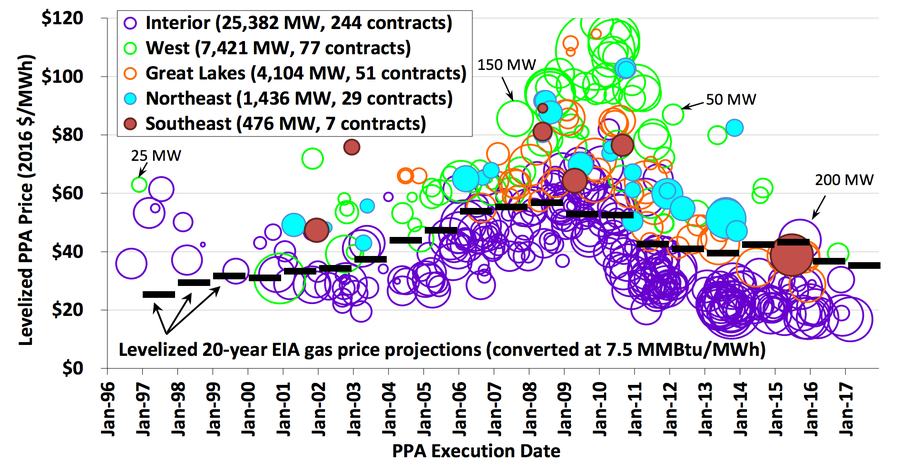
This figure compares the power purchase agreement (PPA) contract price for wind energy (circles) to the levelized cost of natural gas (black bars) based on Energy Information Administration (EIA) projections. The diameter of each circle represents the capacity of the wind farm contracted in megawatts. Wind energy built in the U.S. interior has come in at or below long-term gas price projections since 2011. In recent years, the price of interior wind has fallen below 20 dollars per megawatt-hour, or 2 cents per kilowatt-hour. Credit: Wind Technologies Market Report Lawrence Berkeley National Laboratory
In recent years, an enormous amount of wind energy has been procured at or below a price of 20 dollars per megawatt-hour — or just 2 cents per kilowatt-hour. That is competitive with typical wholesale electricity market prices by any measure.
But it’s important to note that the price of wind energy offered through a PPA is an all-in price that includes the effect of subsidies such as the federal wind production tax credit, which provides a tax subsidy of 18 to 23 dollars per megawatt hour of energy produced. When you exclude the production tax credit and look at the levelized cost of energy (LCOE) from interior wind, it still comes in at an extremely competitive cost of less than 50 dollars per megawatt-hour (5 cents per kilowatt-hour). For comparison, the Energy Information Administration estimates a best-in-class combined cycle natural gas power plant has an LCOE of about 54 dollars per megawatt-hour (5.4 cents per kilowatt-hour). So even when you account for the effect of the federal wind production tax credit, wind energy remains an extremely competitive generating resource.
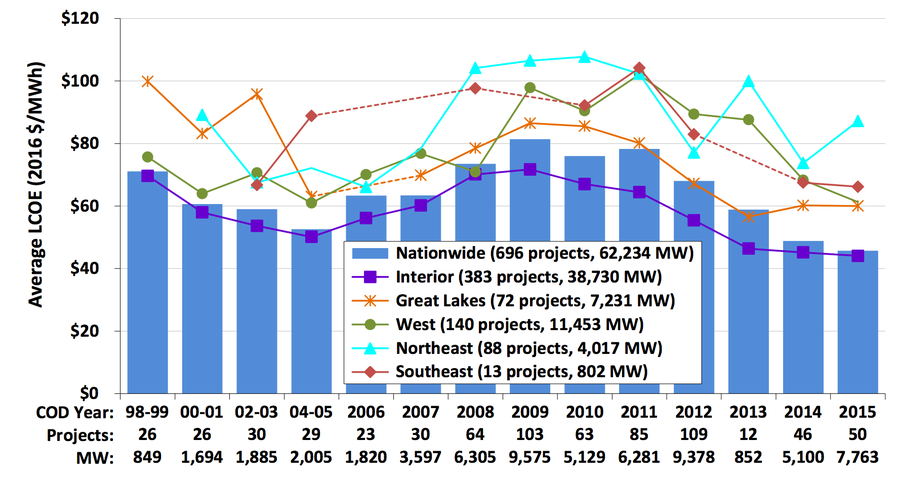
The levelized cost of energy (LCOE) reflects the average cost of wind energy excluding any federal tax benefits or other subsidies. Interior wind built in 2014 and 2015 has an LCOE of less than 50 dollars per megawatt-hour, or 5 cents per kilowatt-hour. For comparison, the Energy Information Administration estimates a best-in-class combined cycle natural gas power plant has an LCOE of about 54 dollars per megawatt-hour, or 5.4 cents per kilowatt-hour. Credit: Wind Technologies Market Report Lawrence Berkeley National Laboratory
Competition Is Driving Wind to Be Cheaper, Bigger, and Better
One of the benefits of wind energy becoming fully competitive with conventional fossil-fuel electricity generation is that it places significant pressure on the wind industry to continually improve the cost and performance of their wind turbines to stay one step ahead of the competition.
Industry data show that wind turbines deployed in 2016 has larger diameter rotors, which allow them to capture more wind overall, and higher hub heights, which allow them to capture the more-steady winds available at higher altitudes. The average rotor diameter in 2016 was 108 meters, a 13 percent increase over the previous 5-year average, while the average hub height in 2016 was 83 meters, up 1 percent over the previous 5-year average. As a result, the average generating capacity of newly installed wind turbines in the United States in 2016 was 2.15 megawatts, up 11 percent from the average over the previous 5 years.
Improvements in wind turbine design have not only helped to increase the maximum power they can produce (or their generating capacity), but also their capacity factor, a measure of how often they actually produce energy. The average capacity factor of projects installed in 2014 and 2015 was over 40 percent — meaning they produced 40 percent of the maximum possible energy they could produce if it were very windy 24 hours a day, 365 days a year.
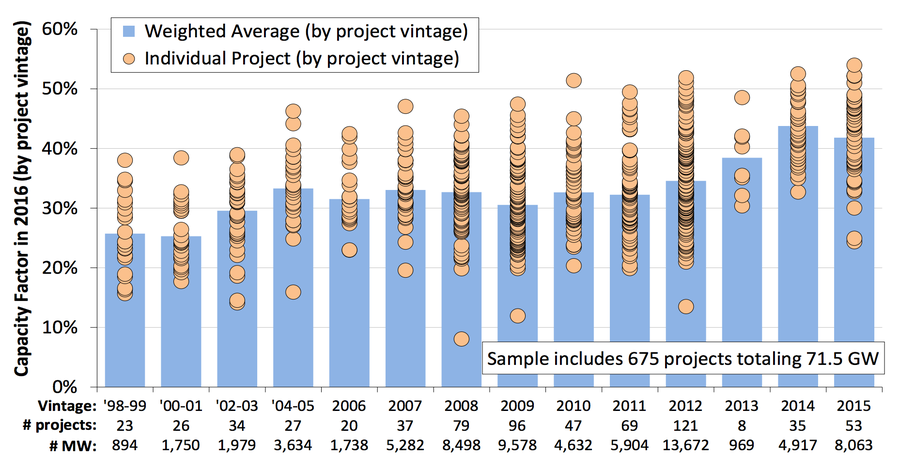
Improvement in wind turbine design has driven significant increases in wind farms’ capacity factor, a measure of how often they actually produce energy. The average capacity factor among projects built in 2014 and 2015 was 42.6 percent, compared to an average of 32.1 percent among projects built from 2004 to 2011 and 25.4 percent among projects built from 1998 to 2001. Credit: Wind Technologies Market Report Lawrence Berkeley National Laboratory
What About Integration Costs Associated with Wind Variability?
At this point you might be asking, what about all the costs associated with wind variability? Don’t we need storage to manage fluctuations in wind energy output? Unfortunately, there are no short answers to what the costs of integrating a variable source of electricity like wind are. The answer is a definitive “it depends.”
One thing we can do is look at how the amount of wind forcibly turned down, or curtailed, by grid operators has changed as the amount of wind energy on the grid has increased. The figure below shows both wind penetration rates and wind curtailment rates between 2008 and 2016 for seven U.S. independent system operators (ISOs) (map of U.S. ISOs here).
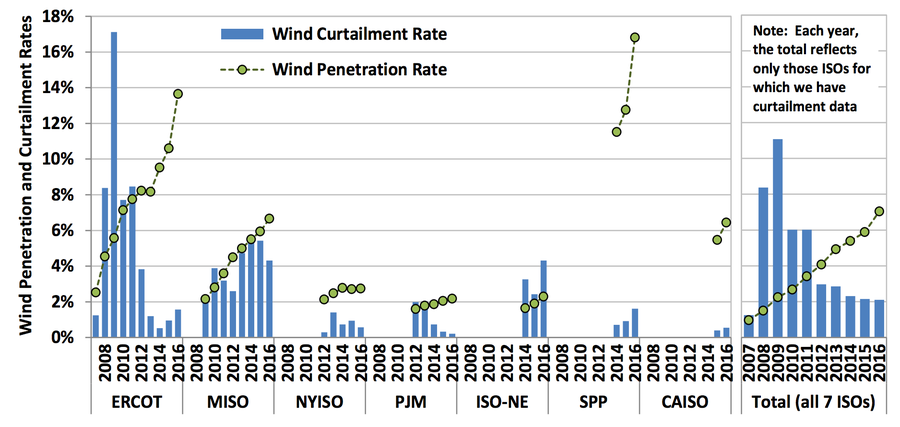
This figure tracks changes in wind penetration and wind curtailment, or the amount of wind generation that is forcibly turned down by the grid operator, across seven U.S. independent system operator (ISO) regions. While wind penetration has increased significantly, wind curtailment has decreased due to transmission investments and other operational changes to accommodate wind energy. Credit: Wind Technologies Market Report Lawrence Berkeley National Laboratory
When you look at the total change in wind penetration and wind curtailment across all seven ISOs, curtailment has actually decreased even though wind penetration has significantly increased. This doesn’t mean that the costs of integrating wind are not significant. In fact, a big reason curtailment has decreased since its peak is 2009 is that regions have been investing in large-scale transmission lines to pipe wind power from the plains to the cities, and better balance wind power output with demand. In the Electric Reliability Council of Texas (ERCOT) region, for example, utilities invested $7 billion in transmission lines linking windy West Texas to the eastern and central cities — significantly reducing curtailment. Like all investments in transmission lines, those costs were spread throughout the entire customer base, so they are not reflected in the cost of wind energy shown in the charts above. But when you spread a billion-dollar investment across millions of customers, the cost incurred per customer is relatively modest.
As the exceptionally low price of U.S. wind energy drives further wind farm installations, it will be interesting to see how U.S. grid operators manage the challenge of integrating wind energy with the rest of the grid. So far, at least, they’ve been successful. But policymakers and regulators should be cognizant of the need for new transmission capacity and other grid upgrades to integrate wind as more turbines are installed in more places. Identifying the lowest cost investments to integrate the most renewable energy is not a simple task — but it will become increasingly vital as renewables throw off the "alternative energy" label and become a major contributor to the U.S. electricity supply.
